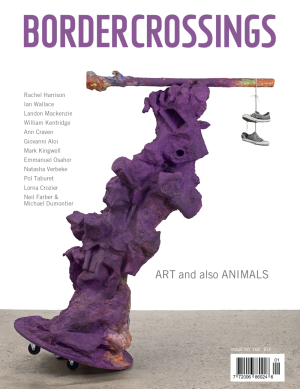“Fitzgerald as Print-Maker” by Helen Coy
Canada lacks basic books about its art. It is a common practice to produce works of the coffee-table kind — large tracts of Canadian art history, or a polyglot glance at a School or region. But one looks in vain for the store of solid, individual studies that ought to precede the larger generalizations and surveys. Before these individual studies can be made, however, there is yet another step necessary. The historian, or the critic, needs reference tools. He needs directories of artists, he needs factual biographies that will include details of an artist’s influences and sojourns in various places; he needs lists of exhibitions and their contents, not only relating to the artist himself but also of those exhibitions the artist may have seen. Above all, the scholar needs accurate and comprehensive catalogues raisonnés. The more advanced mature critical structures can never be written until this honest spadework is done.
A work like FitzGerald as Printmaker, therefore, is particularly welcome. Its aim is to document every print made by FitzGerald, and to detail the circumstances during and after their production. In other words, it gathers together in one place almost all the factual information about FitzGerald’s prints that any serious student might need.
Accuracy is of the essence of such books, obviously, and it is unfortunate that this catalogue raisonné is not impeccable in this respect. A disturbing example appears in the introductory essay that purports to clear up the confusion surrounding the medium used by FitzGerald in his intaglio prints. For many years, the dry-points have been mistaken for etchings or engravings, and it is important that this catalogue should resolve the matter clearly and authoritatively. Yet the account of the investigation is itself inaccurate. It gives the distinct impression that the School of Art at Winnipeg first established that most of the “engravings” were in fact dry-points, with the National Gallery backing up the research later. However, in answer to my enquiry, Mr. Kevin Forrest (author of a 1979 thesis on FitzGerald’s prints) has pointed out that it was the National Gallery’s examination of “Backyards, Water Street” carried out two years before the tests at the School of Art (at Mr. Forrest’s request) that alerted scholars to the confusion. Such an error, if spotted too late for revision, ought at least to have been acknowledged by means of an erratum slip.
If accuracy is important, so is completeness. One imagines that collectors, curators, or dealers will turn to this catalogue in order, amongst other things, to establish which particular state of a print they possess. Yet for only a few of the prints does the catalogue illustrate all the progressive states. In other cases, it contents itself with a verbal description of the progressive alterations. The editor might just as well have gone the rest of the way and illustrated all states, especially in view of the fact that not very many prints are involved. Neither are we told which state is being illustrated, although one deduces that it is probably the final state in each case. And then, some explanation might have been provided as to exactly how the prints are measured, including a statement of the policy adopted about image size versus plate mark size. This is particularly necessary in view of the fact that some of the illustrations include the plate mark (the preferable practice) and some do not, so that the reader is not entirely sure, in the latter case, whether part of the image has been cropped. Finally, in such tiny prints as most of FitzGerald’s are, it might have been more appropriate to follow the growing practice of giving the measurements in millimetres rather than centimetres. Such matters might seem trivial, yet the book as a whole is meticulous enough to make one regret the lack of the extra care that would have made it even better.
These grumbles out of the way, it is possible to examine the catalogue as a record of FitzGerald’s achievement in prints. It is not a major achievement. The intaglios are easily the best prints in the book; the Christmas cards and the so-called Utility Prints are for the most part run-of-the-mill, even banal images. Yet even the intaglio prints are nothing like as impressive as FitzGerald’s work in other mediums. He worked only spasmodically on them, and at one point abandoned them altogether. Possibly this was because he lacked proper facilities at Winnipeg, or because he did not receive the needed encouragement. But there may have been other reasons. The medium was not entirely sympathetic to his purpose. The ground of an etching has its own resonance and mood that do not suit the two elements that constitute FitzGerald’s mature style: the tension between line and volume, and the still, crystalline spaces. In the major dry-points, those that come nearest to FitzGerald’s concerns in his painting and drawing (“Backyards, Water Street,” for example, or “Trees and Houses, Winter”) there is a sense of strain, of trying too hard, that results in stiffness. It is significant that the most attractive prints are the tiny landscapes from 1923 which were done on the spot, without much forethought or reworking. The very early informal nudes, too, are exquisite.
Given the slightness of FitzGerald’s achievement as a printmaker, the question arises whether such an exhaustive record is justified. The answer is assuredly yes. FitzGerald’s continuing experiments in prints throw interesting sidelights on his development in the other modes where his importance is undisputed. And then, any documentation from Winnipeg of this period is vital in helping us piece together the beginnings of artistic endeavour in that region. The book is one of the small, but essential preliminary steps needed before Canadian art studies can come fully of age. ■
Peter Millard is a critic and curator who lives in Saskatoon.

